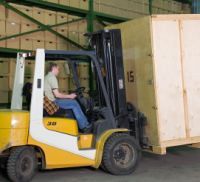

As readers of our Monthly Bulletins, you will no doubt have noticed over the course of the year that cases of accidents at work involving forklift trucks have been on the increase. In 2007 alone, the UK has seen around eight workers killed by forklift trucks, with more than 400 employees every year suffering amputations, fractures, dislocations, resuscitation or a stay in hospital following an accident with such vehicles.
Forklift trucks cause far more serious injuries than any other kind of workplace accident, and over 1,200 people each year take three or more days sick leave after a related incident. This figure is more than cars and heavy goods vehicles combined. In fact, this month's bulletin could have consisted entirely of forklift truck horror stories, with fines totalling £89,390 handed out to Community Waste and Waterline Limited for incidents which have seen their employees severely injured at the steel hands of forklifts. Expect similar results in the near future, with Denfind Farm and building contractors A Thorburn currently under investigation following crushes by the vehicles.
Employers are responsible under the Health and Safety at Work etc. Act 1974 and the Management of Health and Safety at Work Regulations SI 1999/3242, to ensure the welfare of their employees and to make an assessment of the risks to their health and safety. In addition, the Workplace (Health, Safety and Welfare) Regulations SI 1992/3004 make provision for the organisation of traffic movements within premises, so vehicles and pedestrians can move around safely. Considerable Health and Safety Executive (HSE) guidance is also available on working with forklift trucks, which details:
For more information, see: